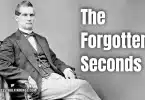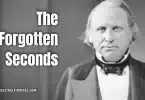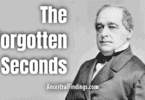Nelson Aldrich Rockefeller was born into wealth so vast that most Americans in the early 20th century couldn’t comprehend it. Born on July 8, 1908, in Bar Harbor, Maine, his life began with a silver spoon—and possibly a silver platter. But behind the art collections, philanthropy, and power dinners at Pocantico Hills was a complex man with ambitions that extended far beyond the trappings of wealth. He wanted to be president. He tried several times. But despite a pedigree that read like royalty and a political resume that dwarfed many of his peers, he never entirely made it.
The Rockefeller Bloodline: From Oil Barons to Statesmen
To understand Nelson Rockefeller, one must start not just with his father, but with the titanic figure of his grandfather: John D. Rockefeller, Sr. Born in 1839 in Richford, New York, John D. came from modest beginnings. His father, William Avery “Devil Bill” Rockefeller, was a snake oil salesman and self-proclaimed “botanic physician,” who vanished from the household for long stretches. Devil Bill was hardly a role model, but his son John D. became one of American history’s most disciplined and calculating businessmen.
By the early 20th century, John D. Rockefeller Sr. had built the Standard Oil Company into an empire controlling over 90% of U.S. oil refining and distribution. Antitrust legislation eventually forced the company’s breakup in 1911, but Rockefeller’s wealth was so immense that he remained the wealthiest man in America for decades. His children were raised with strict Baptist principles, taught to give back to society, and trained to manage the growing family fortune with discretion and control.
John D. Rockefeller Jr., Nelson’s father, was the only son of the oil magnate. Born in 1874, he married Abby Greene Aldrich, the daughter of powerful U.S. Senator Nelson W. Aldrich of Rhode Island. Abby was cultured, refined, and fiercely intelligent. Her father, for whom Nelson Rockefeller was named, was a dominant figure in Republican politics and helped shape early 20th-century financial and banking policy. This union of Rockefeller oil and Aldrich politics created a new American aristocracy that raised its children to preserve wealth and wield influence.
Growing Up Rockefeller
Nelson Aldrich Rockefeller was the third of six children. Unlike the gilded stereotype one might expect, his upbringing was carefully managed by his mother, Abby, who instilled in her children a sense of duty and public service. From an early age, Nelson displayed boundless energy and an eye for detail. He was also dyslexic, though this was not widely acknowledged then. He overcame it through sheer willpower, developing a strong memory and honing a charismatic speaking style.
He graduated from Dartmouth College in 1930 and quickly immersed himself in the family business of influence—art, finance, diplomacy, and politics. But Nelson didn’t want to attend cocktail parties or sit on museum boards merely. He tried to shape America.
A Political Life Begins
Before his political career officially started, Nelson Rockefeller had already made a name for himself in global affairs. During World War II, he served as Coordinator of inter-American affairs under Franklin D. Roosevelt and later as Assistant Secretary of State for Latin American Affairs. His ability to cut through bureaucracy and get things done earned him bipartisan respect.
His love for modern art led to key contributions to the Museum of Modern Art, which his mother co-founded. But his passion for bold ideas and his take-charge personality often put him at odds with more cautious government figures.
In 1959, Rockefeller was elected governor of New York. He would serve four terms, holding the office until 1973. His tenure was defined by big projects: vast expansions in education, new highways, bridges, and housing, and the infamous construction of the massive Albany government complex. He threw money at problems in ways that made fiscal conservatives wince, but his support for civil rights, labor, and public health made him a hero to moderates and liberals.
The Attica Prison Uprising
One of the darkest chapters of his governorship came in 1971, when prisoners at the Attica Correctional Facility rioted and took control of the prison, demanding better conditions. Rockefeller, who was vacationing then, refused to meet with negotiators. Instead, he authorized an armed assault to retake the facility. The result: 43 people dead, including 10 hostages. The brutality of the retaking shocked the nation. To this day, it remains a stain on his legacy and a symbol of governmental overreach.
The Pursuit of the Presidency
Nelson Rockefeller’s presidential ambitions were no secret. He sought the Republican nomination three times—in 1960, 1964, and 1968. But each attempt failed, in part because the Republican Party was shifting. His positions on civil rights, expansive government, and social programs made him a darling of the liberal Northeastern Republicans—the so-called “Eastern Establishment”—but increasingly out of step with the conservative base.
In 1964, he led the primary race until his personal life became political fodder. After divorcing his wife of three decades, he married Margaretta “Happy” Murphy, a recently divorced woman who had previously worked as his aide. The scandal damaged his support, and Barry Goldwater surged ahead to take the nomination. In 1968, he tried again, but Richard Nixon had the momentum.
Vice President Under Gerald Ford
After Nixon’s resignation in 1974, Vice President Gerald Ford ascended to the presidency. Using the 25th Amendment, which allows the president to nominate a vice president when the office is vacant, Ford chose Rockefeller. The decision shocked many. Though Ford was a Midwestern conservative, he respected Rockefeller’s competence and experience.
Nelson accepted with characteristic enthusiasm, but his time as vice president was strange. He had little real power. Ford, looking toward the 1976 election, began distancing himself from the liberal Rockefeller. By the time the next campaign rolled around, Ford replaced him with Kansas Senator Bob Dole, hoping to appeal to the Republican right.
Rockefeller, sidelined but still energetic, was reportedly humiliated by the decision. Though he continued to support public causes and remained active in policy circles, his dream of becoming president was officially over.
A Sudden End and a Final Scandal
Nelson Rockefeller died on January 26, 1979, at 70. The circumstances of his death sparked headlines and hushed whispers. Initial reports stated he died at his desk, working late. Later revelations disclosed he died in the presence of a young aide, Megan Marshack, at a private residence. The Rockefeller family, known for its tight public image control, remained silent. Whatever the truth, the flamboyant statesman exited the world with the same mix of admiration and controversy that had always followed him.
Legacy of a Complex Giant
Rockefeller left behind a country that had shifted far from his brand of Republicanism. His political ideology—fiscally ambitious, socially moderate, and proudly internationalist—has few heirs today. Yet his impact on American architecture, art, public health, and education remains strong.
Nelson Rockefeller was never boring, from his deep family roots in oil and political reform to his towering ambitions and equally large missteps. He may have never been president, but he lived, governed like one, and built a legacy that refuses to be forgotten.






